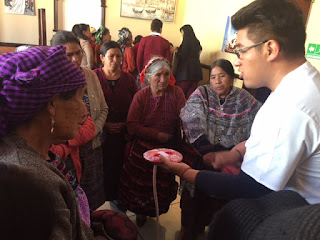Bueno! Hello!
 |
| Nestor and Antonio going all out. |
 |
| Gladys conducting Patient Counseling Dimanica |
Well, our team has had an incredible experience these past two weeks in this beautiful country. Yesterday morning we concluded the week-long training session with 2 sessions before the participants took their final exam. One was a brilliant dinaminca Glady Ramirez of MTI presented covering "Patient Counseling" or "Consejerîa".
Then our teamed focused on Faculty development and presented a very lively workshop on adult based learning, giving feedback especially to different types of learners. We used some of the same concepts that is presented during the ALSO Instructors course and restyled it to the AEIPI/IMCI course. Since all 9 of our participants will be teaching the same course over the course of the next few weeks before they learn the 2nd module, we wanted to help them develop their teaching skills. Culturally, we noted that it is particularly difficult for them to give negative or constructive feedback. So we emphasized the "Feedback Sandwich" technique and had them practice this in small groups. It was particularly enlightening that I encouraged them to use the same paradigm to evaluate our teaching as well. The session was a blast and of course filled with dînamincas, dancing, laughter and hugs.
 |
| Dr Chavez being with two challenging learners - the unprepared and the bored., as Laurie prepares to give feedback too. |
 |
| Teaching the teachers. |
This team of Guatemalan Doctors and Nurses will be teaching weekly the same material over the next 4 weeks to 40 doctors and nurses. We know they will be awesome!
Knowing our work was done for this week, we hoped on a microbus and settled into the 7 hour ride to Antigua to meet the service team that had left that morning. We felt content and pretty happy, so the music was turned up and we sang Bob Marley and Bon Jovi songs together as the bus descended the mountains towards the main highway.
We arrived in Antigua later in the evening about 7:30 pm, had a lovely dinner and then of course, went Salsa Dancing. This time we did not get lost and the band was actually playing when we entered La Palmas Bar at 9:30 am.
 |
| Biance, Laurie and "Ki-Le" salsa'ing away. |
 |
| Two of the Buildings of the Campus |
The rest of the day in Antigua, our group split up into small pairs and triplets and took in the beauty and clamor of this beautiful colonial old capital of Guatemala. We are meeting for dinner soon and then its lights out for an early morning departure back to the US.

We all are so appreciative to Providence Health, Project Concern and Medical Teams International for giving us all this opportunity these past two weeks. We thank our families and colleagues back home for all they have been doing so we could be here. We mostly want to express our gratitude to all the people of the communities of Huehuetenango, San Antonio de Huista, Santa Eulalia and of Uspantan and Chicaman in Quiche, Guatemala.
Until Next Time, Our hearts, minds and spirit is with you. Amor y Hasta Luego a todos.
Robert Gobbo M.D. (El Loro Verde)












































